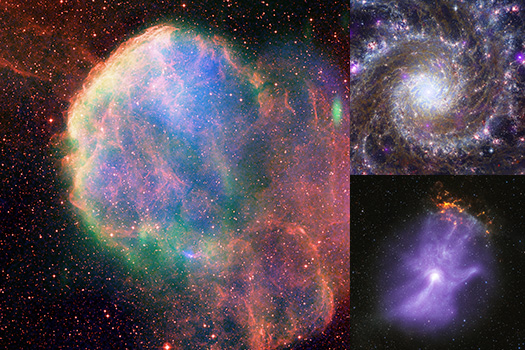Listen to the Universe: New NASA Sonifications and Documentary

IC 443, M74, and MSH 15-52
Sonification Credit: NASA/CXC/SAO/K.Arcand, SYSTEM Sounds (M. Russo, A. Santaguida)
Three new sonifications of images from NASA’s Chandra X-ray Observatory and other telescopes have been released. This work is also being featured in a new NASA+ documentary, "Listen to the Universe."
Sonification is the process of translating data into sounds. In the case of Chandra and other telescopes, scientific data are collected from space as digital signals that are commonly turned into visual imagery. The sonification project takes these data through another step of mapping the information into sound.
IC 443 (Jellyfish Nebula):
IC 443 is a supernova remnant, or the debris of an exploded star, which astronomers have nicknamed the Jellyfish Nebula. A visual composite image of IC 443 includes X-rays from NASA’s Chandra X-ray Observatory and German ROSAT X-ray telescope (blue) along with radio data from the NSF’s Very Large Array (green) and optical data from the Digitized Sky Survey (red). The sonification of IC 443 begins with a top-down scan as the brightness of the data is correlated to the volume of the sound. The sounds are mapped to colors in the image with red light being heard as lower pitches, the green as medium, and the blue light as the higher pitches. This creates notes that sweep up and down in pitch continuously. Several colors are isolated and control the volume of sustained tones with red controlling the lowest note and white controlling the highest note. The background stars in the optical image have been converted to water drop sounds in the sonification.
M74 (Phantom Galaxy):
Messier 74 is a spiral galaxy like our Milky Way, which is seen face-on from Earth’s vantage point some 32 million light-years away. X-rays from Chandra (purple) have been combined with an infrared view of M74 from NASA’s James Webb Space Telescope (green, yellow, red, and magenta) as well as optical data from NASA’s Hubble Space Telescope (orange, cyan, and blue). In sonifying these data, a clockwise-moving radar-like scan starts around 12 o’clock. The distance from the center controls the frequencies of sound with light farther from the center being higher pitched. The Chandra sources correspond to relatively high musical pitches of glassy ethereal and clear plucked sounds. In the Webb data, large, medium, and small features are represented by low, medium, and high frequency ranges of pitches respectively with the brightest stars being heard as percussive sounds. The Hubble data have been turned into breathy synthesizer sounds along with thin metallic plucked sounds for bright stars and clusters.
MSH 15-52 / PSR B1509-58:
The third new sonification is of MSH 15-52, a cloud of energized particles blown away from a dead, collapsed star. This image includes X-rays from the Imaging X-ray Polarimetry Explorer, or IXPE, (purple) as well as Chandra (orange, green, and blue). These data have been combined with infrared data from the Dark Energy Plane Survey 2 (red and blue). In sound, the scan goes from the bottom to the top. The brightness of the Chandra data of the cloud have been converted into rough string-like sounds, while the blast wave is represented by a range of pitches of firework-type noises. The IXPE data are heard as wind-like sounds. The infrared data are mapped to musical pitches of a synthesizer sound. The light curve, or brightness over time, from the dead star’s collapsed core is heard in pulses that occur almost 7 times every second as it does in the original data.
These sonifications were led by the Chandra X-ray Center (CXC) and included as part of NASA's Universe of Learning (UoL) program. The collaboration was driven by visualization scientist Kimberly Arcand (CXC), astrophysicist Matt Russo, and musician Andrew Santaguida, (both of the SYSTEM Sounds project), along with consultant Christine Malec.
NASA's Marshall Space Flight Center manages the Chandra program. The Smithsonian Astrophysical Observatory's Chandra X-ray Center controls science from Cambridge Massachusetts and flight operations from Burlington, Massachusetts. NASA's Universe of Learning materials are based upon work supported by NASA under cooperative agreement award number NNX16AC65A to the Space Telescope Science Institute, working in partnership with Caltech/IPAC, Center for Astrophysics | Harvard & Smithsonian, and the Jet Propulsion Laboratory.
Please note this is a moderated blog. No pornography, spam, profanity or discriminatory remarks are allowed. No personal attacks are allowed. Users should stay on topic to keep it relevant for the readers.
Read the privacy statement
